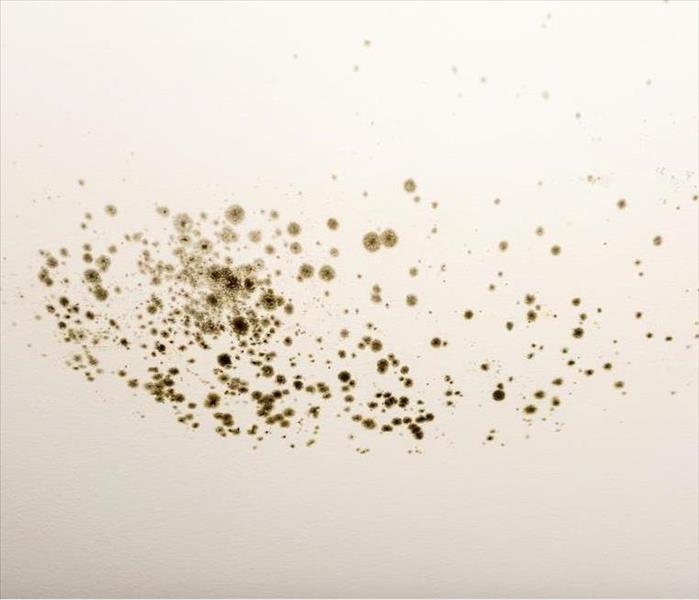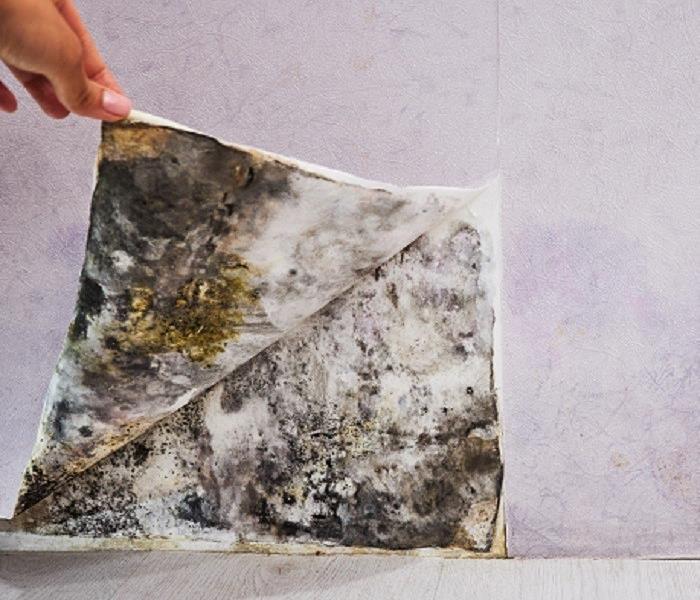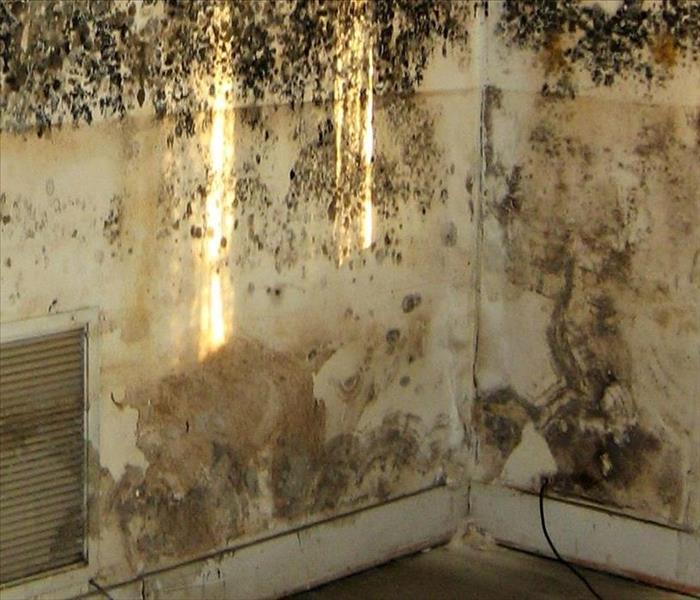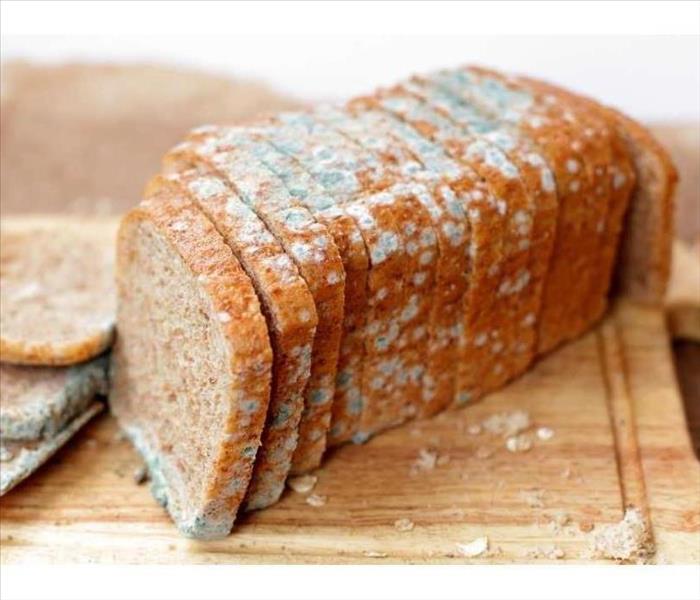Archived Mold Remediation Blog Posts
What Everyone Must Know About Irwindale Mold Damage Remediation
2/17/2019 (Permalink)
 Don't attempt to clean any mold that you find in your home. You may only spread the infestation further. Call SERVPRO to investigate.
Don't attempt to clean any mold that you find in your home. You may only spread the infestation further. Call SERVPRO to investigate.
Defining Mold Remediation for Irwindale Homes
While many Irwindale homeowners might be familiar with mold and the kind of damage that it can do to a property, they do not fully understand the process required to remove that threat from their homes. As many might have already seen on the Internet, there are many “mold removal” strategies that guarantee the removal of all mold in your home with simple solvents and detergents, but these are inaccurate. In truth, mold exists naturally in nearly every environment, so removing it entirely is not just improbable, it is impossible.
Our approach to mold damage in your Irwindale home is a process called remediation. This system targets the colonization and spread of mold throughout your home and removes these colonies that form. While microscopic spores on their own do not damage your house and threaten the health of its occupants, when moist conditions allow for these spores to seat into materials, the colonies can prove hazardous to the structure.
The initial steps of remediation from our SERVPRO professionals centers on containment. By removing the ability of mold colonies to spread farther throughout your home, we can work quickly on existing organisms and remove them. While remediation does often require material removal, especially on porous surfaces like drywall, our team also features licensed contractors to help make this reconstruction process seamless, time-saving, and cost-effective.
We can even remove lingering musty odors that accompany mold colonization through the use of our advanced equipment. This process is even more effective when containment strategies remain in place, as it helps to prevent the odor from spreading throughout the property. Machines such as our hydroxyl generators and thermal foggers can work to remove foul odors from damaged contents and open areas to make mold growth “Like it never even happened.”
Remediation is not the same as mold removal, but it can help you to recover your damaged property once mold colonization has occurred. You can count on our experienced SERVPRO of Irwindale / Baldwin Park mold remediation specialists to arrive quickly, 24/7, by calling (626) 337-3374.
Click here for more information about Irwindale.
Baldwin Park Moldy Carpets?? SERVPRO Can Try to Restore
1/3/2019 (Permalink)
 The SERVPRO Green Fleet Is Always a Welcome Sight for Baldwin Park Homeowners with a Mold Problem
The SERVPRO Green Fleet Is Always a Welcome Sight for Baldwin Park Homeowners with a Mold Problem
Identifying and Remediating Carpet Mold in Your Baldwin Park Home
When Baldwin Park homeowners think of disastrous situations for their home, they do not often think of threats that can originate inside. While many natural disasters could potentially affect our service area throughout the years, a steady concern for homeowners in our community is mold growth. Several scenarios can cause this growth and spread throughout your home, and taking care of the situation immediately can help preserve affected elements in your house and those that live there.
As widespread as mold damage can be in your Baldwin Park home, there are many situations in which mold and mildew remain isolated to certain areas like carpeting. Overcoming these effects is rarely something that a homeowner can do on their own, but our SERVPRO professionals have the expertise and industry-leading equipment to make a significant difference right away. It is our goal to preserve mold-damaged materials like carpeting and wood floors as much as possible.
Often when mold has affected carpet flooring, the damage can spread quickly to the point that there is no realistic method of preserving it and returning it to its original condition. Instead, our SERVPRO professionals work to quickly remove the affected carpets from the damaged areas and set up our drying equipment like air movers and dehumidifiers to get to work on the subflooring and base to dry these elements out. We can reinstall carpeting to return the damaged areas to their original luster once the mold colonies have gotten safely removed and the area thoroughly dried.
The SERVPRO professionals sent out to your address can determine mold types, the full extent of the damage, and the best direct approach to take to restore the construction materials to minimize the need for reconstruction and remodeling once the mold gets removed.
Restoring your carpets that have gotten affected by mold growth might be a challenge, but our SERVPRO of Irwindale / Baldwin Park remediation specialists can work quickly to preserve all possible materials and work to save our customers time and money. Often, there is not recourse, but to discard badly mold damaged carpeting. Give us a call whenever you find mold in your home at (626) 337-3374.
Welcome to our city--click
How Can You Prevent Mold From Growing in Your Baldwin Park Property?
1/3/2019 (Permalink)
 Is mold hiding in your home? Call SERVPRO today to remediate the mold!
Is mold hiding in your home? Call SERVPRO today to remediate the mold!
Mold Removal and Prevention Techniques for Baldwin Park Homeowners
Homeowners in Baldwin Park who find moldy areas of their residence often want to avoid the problem in the future. SERVPRO technicians can help protect your property from developing more severe problems from overgrowing microbes.
When a home in Baldwin Park develops mold, removal and prevention techniques can help keep the property healthy. Mold can cause health effects when left growing, so remediation and prevention becomes an essential and crucial method of protecting your family.
SERVPRO specialists hold certificates from the IICRC and know the most effective methods to remove mold from your home. These also prove to be the most cost-effective ways to prevent mold from regrowing.
Locating the water used by microbes means we can shut it off and prevent mold from remaining hydrated. Once mold dries out, it becomes dormant and quits growing. Water sources can include cracks in slab foundations over saturated soils, leaking plumbing, fixtures, or appliances, past overflows, or breaks in shower and tub surrounds that allow water to escape. When the water source is from a one-time event, we direct our efforts immediately on eliminating the remaining moisture. When continued water loss occurs, we repair the troublesome situation.
Removing the mold happens with scraping, blasting, or removal of materials. We choose the appropriate method according to the amount of damage and which material shows infestation activity. After we finish, we move forward with preventative techniques.
These include discussing how to alleviate situations that involve ongoing structural deficits like damp slabs and other areas that continue to produce moisture. A dehumidifier might suffice, or we can help you locate a certified and licensed contractor with experience in making these kinds of repairs. We also treat the areas affected by mold after we remove existing infestations with a very effective antimicrobial agent that not only kills any newly deposited spores but continues to make the surface inhospitable to any new ones that find their way to the treated location.
SERVPRO of Irwindale / Baldwin Park can help you protect your home and family with competent mold removal specialists. Making everything “Like it never even happened.” is one way we serve our community and make it stronger. Call us at our 24-hour service line, (626) 337-3374, 365 days a year.
Baldwin Park was incorporated in 1956. Click here to read more.
What is Mold?
8/1/2018 (Permalink)
What is Mold?
We hear a lot in the media these days about the dangers of exposure to mold, but what is mold exactly, anyway? Mold is not a plant or an animal, but a type of fungi. We eat some types of fungi, like many kinds of mushrooms and the yeast we use to make bread rise. Some types of mold are even used to make medicine, like the type of mold that is used to make penicillin, a life-saving antibiotic.
There are hundreds of different kinds of mold found both indoors and outdoors. Mold grows in damp, dimly-lit areas. Indoors, it can often be found in places like attics, basements, crawl spaces, and bathrooms. Mold is also common in other areas if there is a leak in the roof, leaky windows, leaky pipes, or seasonal flooding. Some molds commonly found indoors include aspergillus, chaetomium, cladosporium, penicillium, and stachybotrys.
Mold growth requires moisture. The sources of moisture could be washing, cooking, air humidifiers, condensation or leaks from plumbing or from the outside. Poor ventilation contributes to higher humidity levels and leads to condensation, which also allows mold growth.
You may begin to notice a damp, must odor in a specific area of your home. This means you should check for damp walls, carpet, flooring and any other spaces that may be breeding grounds for mold. The key is to treat a mold problem immediately, before the infestation becomes worse or causes permanent damage.
What is Mold Remediation?
Mold remediation is the process of removing mold and repairing mold-related damage in the home. It’s a complicated process and must be done carefully in order to prevent further exposure to potentially harmful mold spores. Mold can be cleaned from some materials, like bathtubs and tile, and the surfaces disinfected. Some materials, though, like drywall, wood, and carpeting, are impossible to clean thoroughly and instead must be removed and replaced.
Mold remediation is challenging in part because mold can grow in so many out-of-sight places, including inside walls, under carpeting, above ceiling tiles, and inside heating and air conditioning ducts. Just locating all the mold can be difficult, and if you miss even a little bit, it will just continue to grow and spread. Soon you’ll have a full-blown mold problem on your hands again.
When it comes to mold in your home, leave it to the professionals and call SERVPRO of Irwindale/Baldwin Park to help make it “Like it never even happened.”
http://www.moldbacteriafacts.com/what-is-mold/
https://www.mold-advisor.com/what-is-mold.html
How to Prevent Mold Growth in your Kitchen
5/22/2018 (Permalink)
Since food is stored in the kitchen (most of the times), keeping your kitchen clean and well-aired will have a major impact on your food’s life. For example, mold will develop anywhere where there is a leak, and if you are storing food close to that it can easily transfer from a corner and attack your favorite otherwise fresh food.
In order to prevent mold on food you will have to work on overall kitchen mold prevention. In most cases it includes either ensuring there is enough fresh air or regular cleaning. Here are a few tips that can help you prevent mold in the kitchen
- Mold can grow in the fridge and, thus, it is important to keep the inside of the refrigerator clean. We suggest cleaning it every few months with one tablespoon of baking soda dissolved in a quart of water. Rinse with clean water and dry thoroughly before storing food again.
- Ensure your food is still fresh by checking it every day or two. Toss away anything that has a sign of mold or that started rotting away.
- Replace sponges at least once a week and always use clean dishcloths and towels. If you notice a musty smell coming from a sponge or towel, replace it immediately.
- Wash the dishes at least once a day. Don’t leave food leftovers in your sink behind you once you are done with the meal. Throw them away immediately. If you are in a rush, keep your dishes under water to prevent food stains from hardening until you can wash them properly.
- Mold can be found in dishwasher and garbage disposals. It can be the reason behind the odors, thus keeping it clean should be your priority. At least once a week pour baking soda, salt and vinegar (or lemon) own the sink and leave it for 10 minutes. After that all you have to do is pour boiled water to wash it up and your disposal and sink will be clean, mold-free and refreshed.
- Kitchen tools, especially wooden ones should be washed and well dried before set aside, because wood is one of the favourite food for mold. All you have to do is simply wash them after you used them and leave them to dry well somewhere where it is not wet and it has enough fresh air and light.
- Don’t forget about unused kitchen appliances. They are often sealed and if not well dried, mold can form due to water evaporation inside. The best way to prevent mold from developing inside is to ensure it is well dried before storing and, if there is a possibility, keep it open.
- And last but not least, make sure that the relative humidity in your home is between 30% and 50%, especially in the warmer months, when mold is known to flourish. The easiest thing you can do to control the humidity level is to keep your windows open as often as possible. If that is not possible your next steps should be either air vents or even a dehumidifier.
If you find that the mold has spread and become a larger issue in the house, you need to take action. Never hesitate to seek professional help from SERVPRO of Irwindale/Baldwin Park.
How to Detect Mold in Your Baldwin Park Home
5/22/2018 (Permalink)
Here are some common signs to watch out for that could indicate you have mold growing in your house.
Smelling a Mold Odor
When you have mold growing hidden away in your house, often a moldy smell might be the only clue that it's there. Don't ignore mold odors if you can't see any mold. You should thoroughly inspect your home before any mold problems get worse.
Seeing Signs of Mold Growth
Visible mold growth might seem like an obvious sign of mold. However many people don't notice small amounts of mold growth or they think it's just soot or dirt. Sometimes people simply ignore visible mold in their house.
If you can see mold growth, even if it's only small, you should take action immediately. Small mold patches can spread and the fact that there is any mold shows that the conditions in your home are right for mold to grow.
If you don't take care of mold it will soon become a bigger problem. Visible mold growth could also be a sign that there is a much larger mold colony growing hidden away from view.
Sometimes you might not realize there is mold in your house, especially if it is unusual looking mold. Some mold growth looks white and thread-like. Other mold appears as clusters of small black spots. Mold can be black, gray-brown, gray-green or white in color. Mold growing behind wallpaper made of vinyl can even appear orange, pink or purple.
Signs of Water Problems
If you have had any long term moisture problems in your house it's usually inevitable they will lead to mold beginning to grow. So if you know you've had some water problems in your home then it's a pretty good sign you could have mold.
Some signs that you have a moisture problem include water stains or discoloration on walls, floors or ceilings in your house. Seeing these could be a clue that there is mold growing within or behind the material.
Another sign of a moisture problem is surface abnormalities like peeling, bubbling or cracking of the paint or wallpaper. If your walls are bowed, bulging or warped it probably means moisture has gotten into them. Another clue is if the surface of walls or other materials feel damp.
Water Leaks
The above signs of water problems in homes are usually created by leaks. However if you already know that you have had a water leak (such as leaking pipes or a leaking ceiling) then just that knowledge by itself, even if you don't see signs of water damage, is a good sign that you might have mold growing in your house around the area where the leak was.
Mold growth from leaks can often be hidden. If the leak was behind a wall or other surface then any mold will probably be hidden behind the surface too. Even if the leak was not behind a surface there could still be mold hidden out of view behind a wall or other surface from water which seeped through.
Past Flooding
If your house has been flooded in the past then it's likely that mold would've started to grow. Any mold would probably be growing in places where flood water remained the longest such as in the basement. Floods can often create mold growing out of view behind walls or under floors.
Condensation
If you see a lot of condensation in your home then it's a sign that you have a high amount of moisture and hence a sign that you could have a mold problem. Condensation will occur on surfaces such as glass windows or metal pipes. Mold could be growing where the condensation builds up and collects. Rusting indoor pipes are a sign that you could have a lot of condensation in your house.
Besides the fact that condensation creates a buildup of moisture for mold to grow on, condensation can also be a sign that you have a humidity problem in your home. A high humidity level can feed mold and it is another sign that you might have a potential mold problem.
 Don't attempt to clean any mold that you find in your home. You may only spread the infestation further. Call SERVPRO to investigate.
Don't attempt to clean any mold that you find in your home. You may only spread the infestation further. Call SERVPRO to investigate.






 24/7 Emergency Service
24/7 Emergency Service


